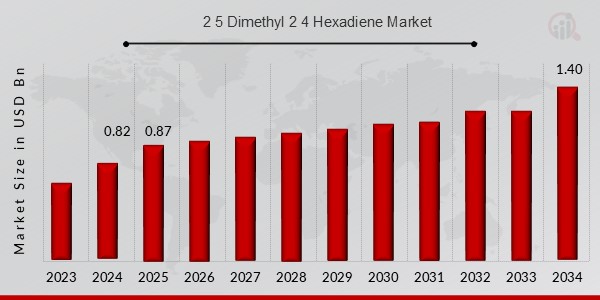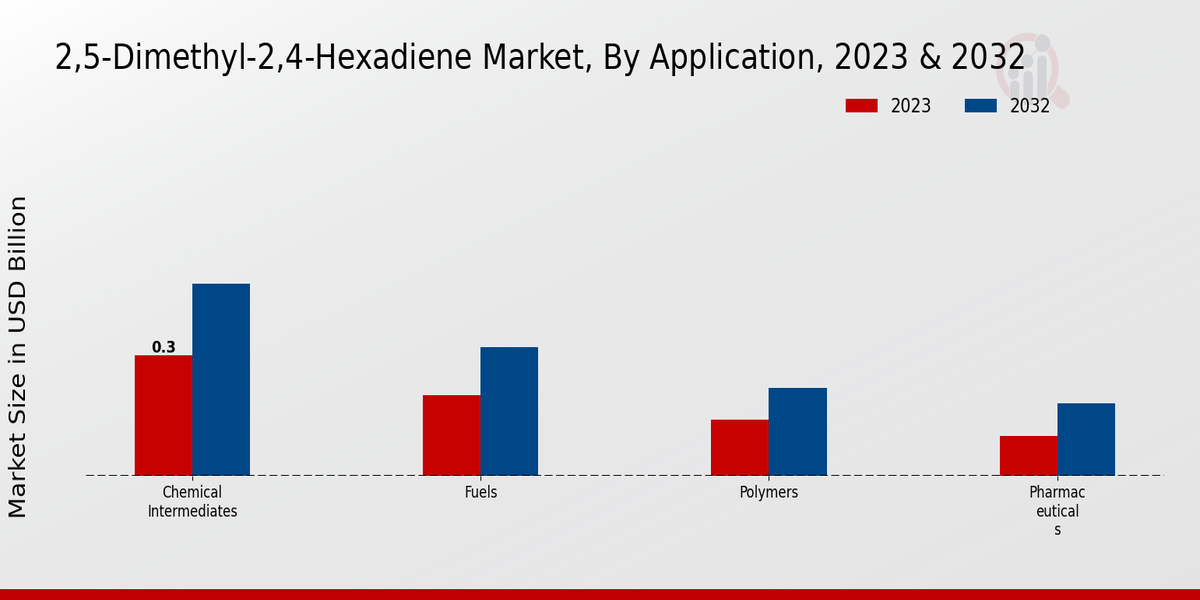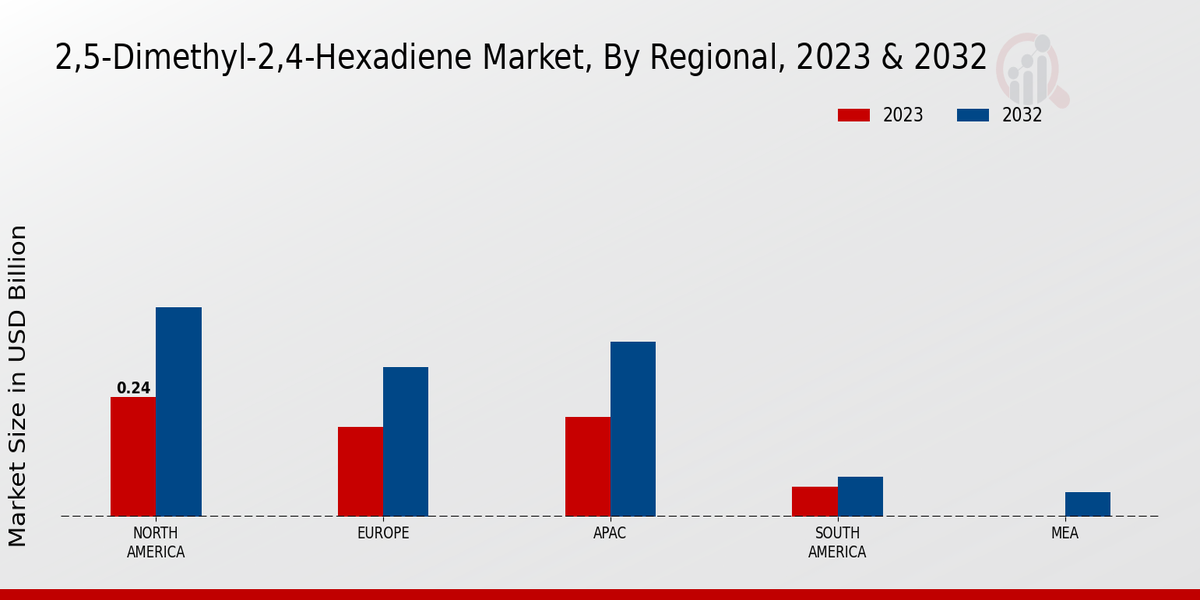Global 2 5 Dimethyl 2 4 Hexadiene Market Overview
The 2,5-Dimethyl-2,4-hexadiene Market Size was estimated at 0.82 (USD Billion) in 2024. The 2,5-Dimethyl-2,4-hexadiene Industry is expected to grow from 0.87USD Billion) in 2025 to 1.40(USD Billion) by 2034. The 2,5-Dimethyl-2,4-hexadiene Market CAGR (growth rate) is expected to be around 5.5% during the forecast period (2025 - 2034).
Key 2,5-Dimethyl-2,4-hexadiene Market Trends Highlighted
The 2,5-Dimethyl-2,4-hexadiene Market is influenced by several key market drivers. The growing demand for this compound in various industrial applications, particularly in the production of specialty chemicals, is a significant factor. Increased usage in the manufacturing of additives, polymers, and agrochemicals is fueling market growth. Additionally, advancements in production technology and the need for more efficient and sustainable chemical processes are creating further demand. The focus on developing eco-friendly and high-performance materials is driving manufacturers to explore alternatives like 2,5-Dimethyl-2,4-hexadiene, enhancing its attractiveness in various sectors.Opportunities to be explored in the market include expanding its applications in emerging fields such as bioplastics and biofuels. As environmental concerns rise, the shift toward sustainable solutions presents a chance for businesses to innovate and create new products based on 2,5-Dimethyl-2,4-hexadiene. Research and development efforts can lead to the discovery of new applications that leverage the compound's unique properties. The growing need for specialty chemicals in the automotive and electronics industries also presents a promising avenue for growth, allowing companies to tap into new customer bases. Recent trends in the market indicate a notable shift towards integrating digital technology in production and supply chain management.Companies are increasingly adopting automation and analytics to improve efficiency, reduce costs, and ensure quality control. This trend reflects a broader industry movement towards smart manufacturing. Additionally, collaboration among various stakeholders, including academia and industry players, is becoming more prevalent to foster innovation and share knowledge. The combined focus on sustainability, digitalization, and new applications signifies a dynamic and evolving landscape for the 2,5-Dimethyl-2,4-hexadiene Market.

Source: Primary Research, Secondary Research, MRFR Database and Analyst Review
2,5-Dimethyl-2,4-hexadiene Market Drivers
Growing Demand from Chemical Industry
The 2,5-Dimethyl-2,4-hexadiene Market Industry is experiencing a significant increase in demand from the chemical sector. As industries look for efficient and effective raw materials for various chemical processes, 2,5-Dimethyl-2,4-hexadiene has emerged as a preferred choice due to its advantageous properties. Its unique chemical structure allows it to act as a versatile intermediate for the production of diverse chemical compounds, leading to its growing application in the manufacturing of polymers, synthetic rubber, and various specialty chemicals.Additionally, increasing industrial activities and the expansion of chemical manufacturing facilities are bolstering the requirement for such intermediate compounds. The compound serves as a building block for the production of several industrial chemicals, making it essential for the growth of the overall chemical manufacturing ecosystem. As the economy strengthens and production capacities are enhanced, the driving demand for such chemical intermediates is expected to persist, propelling the 2,5-Dimethyl-2,4-hexadiene Market Industry forward.Furthermore, end-user industries such as automotive, construction, and electronics are increasingly utilizing this compound, thereby enhancing its market significance. As the chemical industry continuously innovates to meet the rising consumer and industrial demands, the growth trajectory for 2,5-Dimethyl-2,4-hexadiene is likely to accelerate, making this market driver a crucial factor to consider.
Technological Advancements in Production Processes
Technological advancements are significantly contributing to the enhanced production processes of 2,5-Dimethyl-2,4-hexadiene, which in turn positively impacts the 2,5-Dimethyl-2,4-hexadiene Market Industry. New and innovative methods of synthesis are being developed to improve yield and reduce production costs, leading to more efficient manufacturing. Companies are adopting advanced technologies, such as catalysts and reaction engineering, which optimize the chemical processes involved in synthesizing this compound.The shift towards more sustainable and green chemical production technologies is also influencing the market, allowing manufacturers to reduce waste and lower the environmental impact of their operations. Thus, technological developments not only enhance productivity but also attract investments into the sector, creating an overall favorable market environment for the 2,5-Dimethyl-2,4-hexadiene Market.
Rising Applications in Various End-user Industries
The diverse applications of 2,5-Dimethyl-2,4-hexadiene across various end-user industries are driving the growth of the 2,5-Dimethyl-2,4-hexadiene Market Industry. This compound finds utility in sectors such as automotive, construction, and electronics, among others. For instance, it is utilized in the production of specialized resins and coatings that are essential for modern construction materials. In the automotive sector, it contributes to developing advanced materials that enhance performance and durability.As the demand for high-quality materials continues to rise, the versatility and applicability of 2,5-Dimethyl-2,4-hexadiene are becoming increasingly valuable, further propelling market expansion.
2,5-Dimethyl-2,4-hexadiene Market Segment Insights
2,5-Dimethyl-2,4-hexadiene Market Application Insights
The 2,5-Dimethyl-2,4-hexadiene Market is projected to be valued at 0.74 USD Billion in 2023, with a notable growth trajectory leading to an anticipated value of 1.2 USD Billion by 2032. Within the Application segment, the market showcases a diverse range of crucial areas, prominently featuring Chemical Intermediates, Fuels, Polymers, and Pharmaceuticals. The Chemical Intermediates aspect commands a significant share, valued at 0.3 USD Billion in 2023 and expected to rise to 0.48 USD Billion by 2032, highlighting its vital role in various chemical syntheses and industrial applications.Fuels also represent a critical component, initially valued at 0.2 USD Billion in 2023, projected to grow to 0.32 USD Billion by 2032, driven by the increasing demand for cleaner and more efficient fuel alternatives, which signifies its expanding relevance in energy sectors. In contrast, the Polymers segment, with a valuation of 0.14 USD Billion in 2023 and an expected value of 0.22 USD Billion in 2032, showcases its growing significance largely in manufacturing and industrial applications where 2,5-Dimethyl-2,4-hexadiene is utilized as a key raw material.Pharmaceuticals, while the smallest component in terms of market value, starting at 0.1 USD Billion in 2023 and reaching 0.18 USD Billion by 2032, remains vital as it underscores the compound's importance in drug formulation and development, indicating a significant growth area to accommodate evolving healthcare needs. The overall trends within the 2,5-Dimethyl-2,4-hexadiene Market suggest that each application plays a pivotal role in driving the industry forward, with opportunities present in bolstering production efficiency and addressing sustainability challenges.Growth drivers in this segment include the rising demand for chemical intermediates across various industries and the pressing need for environmentally friendly fuel options, while challenges remain in keeping up with regulatory changes and achieving cost-effectiveness. These dynamics not only shape the market structure but also underline the continuous evolution of applications tailored to emerging needs within industrial and consumer markets. The overall 2,5-Dimethyl-2,4-hexadiene Market revenue reflects these insights, emphasizing the significance of its application across various sectors and driving innovation to fulfill market expectations and standards.

Source: Primary Research, Secondary Research, MRFR Database and Analyst Review
2,5-Dimethyl-2,4-hexadiene Market End Use Industry Insights
The 2,5-Dimethyl-2,4-hexadiene Market is witnessing substantial growth, particularly within the End Use Industry sector, which accounted for a significant portion of the overall market valuation of 0.74 billion USD in 2023. As industries continue to evolve, a notable demand for products in Chemical Manufacturing emerges, driven by the need for innovative chemical processes and formulations. Agriculture also plays a critical role due to the use of 2,5-Dimethyl-2,4-hexadiene in growth stimulants and crop protection solutions, reflecting an increased focus on sustainable farming practices.The Pharmaceuticals segment indicates a steady demand, leveraging the compound's unique properties for various medicinal formulations. Additionally, the Plastics industry continues to dominate this market segment, as 2,5-Dimethyl-2,4-hexadiene is essential for producing high-performance polymers, meeting the growing demand for lightweight and durable materials. The projected growth in the 2,5-Dimethyl-2,4-hexadiene Market industry highlights the ongoing shifts and adaptations within these sectors, presenting numerous opportunities amid challenges such as regulatory pressures and raw material availability.Insights into 2,5-Dimethyl-2,4-hexadiene Market data and statistics reveal an optimistic outlook as industries seek to harness the compound's potential to drive innovation and efficiency.
2,5-Dimethyl-2,4-hexadiene Market Purity Level Insights
The 2,5-Dimethyl-2,4-hexadiene Market shows promising growth, particularly in the Purity Level segment, which includes various classifications such as Technical Grade, Reagent Grade, and HPLC Grade. As of 2023, the market is valued at 0.74 USD Billion, indicating a robust industrial demand. The significance of Purity Levels is highlighted by their critical applications across several sectors, including pharmaceuticals and chemical manufacturing. Technical Grade is widely utilized due to its cost efficiency for less stringent applications, whereas Reagent Grade is essential for more precise laboratory requirements.HPLC Grade serves a niche but vital role in high-performance liquid chromatography, underscoring its importance for analytical and research purposes. Recognizing the value of these grades contributes to a holistic understanding of the 2,5-Dimethyl-2,4-hexadiene Market segmentation and revenue generation potential, emphasizing the need for quality and purity across diverse applications. Strategies focusing on expanding production capabilities and meeting specific purity requirements are expected to drive market growth in the coming years, capitalizing on the increasing demand for superior-grade products across various industries.
2,5-Dimethyl-2,4-hexadiene Market Form Insights
The 2,5-Dimethyl-2,4-hexadiene Market revenue is expected to reach 0.74 USD Billion in 2023, showcasing a robust market presence. The market encompasses various forms including Liquid and Solid, each contributing uniquely to the overall dynamics. Liquid form dominates the landscape due to its versatility across applications in industries ranging from chemicals to pharmaceuticals, while Solid form holds significant relevance in the production of specialized materials. This segmentation plays a crucial role in the 2,5-Dimethyl-2,4-hexadiene Market statistics, highlighting the importance of these forms in meeting diverse consumer demands.Factors such as increased industrialization and the demand for innovative chemical solutions are driving market growth. Additionally, ongoing advancements in production technologies are aiding in optimizing efficiencies, thus responding better to market needs. However, challenges related to regulatory compliance and environmental concerns could impact future growth. Opportunities remain abundant, particularly in expanding applications of Liquid and Solid forms, which serve as key drivers for sustainability and innovation within the 2,5-Dimethyl-2,4-hexadiene Market industry moving forward.
2,5-Dimethyl-2,4-hexadiene Market Regional Insights
The 2,5-Dimethyl-2,4-hexadiene Market is expected to experience noteworthy growth across regional segments, with a notable overall valuation projected at 0.74 USD Billion for 2023 and increasing to 1.2 USD Billion by 2032. In this context, North America will hold a majority of the market share with a valuation of 0.24 USD Billion in 2023 and growing to 0.42 USD Billion by 2032, making it a significant player due to its advanced industrial sector and high demand for chemical intermediates. Europe follows with a valuation of 0.18 USD Billion in 2023 and expected growth to 0.3 USD Billion by 2032, driven by increasing applications in the automotive and textile industries.The APAC region, valued at 0.2 USD Billion in 2023, is anticipated to grow to 0.35 USD Billion, reflecting the booming manufacturing sector, particularly in countries like China and India. South America is showcasing modest growth, starting at 0.06 USD Billion in 2023 and reaching 0.08 USD Billion, while MEA remains the least significant with 0.05 USD Billion by 2032. The varying growth rates and valuations reflect distinct regional demands and industrial capabilities, shaping the 2,5-Dimethyl-2,4-hexadiene Market dynamics.

Source: Primary Research, Secondary Research, MRFR Database and Analyst Review
2,5-Dimethyl-2,4-hexadiene Market Key Players and Competitive Insights
The 2,5-Dimethyl-2,4-hexadiene Market is characterized by a dynamic competitive landscape, influenced by various factors such as technological advancements, regulatory changes, and evolving consumer preferences. Players in this market are focusing on expanding their product offerings and enhancing their operational efficiencies to gain a competitive edge. The market is also witnessing an increase in strategic partnerships, collaborations, and mergers and acquisitions among industry participants. Moreover, innovation is playing a crucial role in driving growth, as companies invest in research and development to introduce new and improved products that respond to the specific demands of different industries, including chemicals, pharmaceuticals, and manufacturing. The ability to adapt to changing market conditions while ensuring sustainability and compliance will be vital for firms looking to establish a strong foothold in this market.Royal Dutch Shell has a significant presence in the 2,5-Dimethyl-2,4-hexadiene Market, leveraging its extensive experience and resources in chemical production and sustainable practices. The company emphasizes innovative approaches in manufacturing processes, which not only enhance product quality but also ensure environmental sustainability. Royal Dutch Shell benefits from its operational footprint, allowing it to effectively distribute and market 2,5-Dimethyl-2,4-hexadiene across diverse geographical regions. The firm's commitment to research and development enables it to explore new applications and formulations of 2,5-Dimethyl-2,4-hexadiene, thereby catering to a broader spectrum of customers. Additionally, Royal Dutch Shell's strong financial position and established brand reputation further bolster its competitive advantage in this market, facilitating strategic investments in technological upgrades and capacity expansions.INEOS stands out in the 2,5-Dimethyl-2,4-hexadiene Market, primarily due to its robust portfolio and commitment to innovation. The company has developed a reputation for high-quality chemical products and flexible manufacturing capabilities, enabling it to respond swiftly to market demands. INEOS invests heavily in research initiatives aimed at enhancing the efficiency of its production processes while maintaining product integrity. This focus on innovation positions INEOS as a leader in producing specialized compounds, including 2,5-Dimethyl-2,4-hexadiene, catering to a variety of industries. The company's extensive distribution network and customer-centric approach allow for effective market penetration and customer retention, enhancing its overall market presence. INEOS's strategic focus on sustainability and environmental responsibility further solidifies its standing as a prominent player in this sector, appealing to increasingly environmentally-conscious consumers and businesses alike.
Key Companies in the 2,5-Dimethyl-2,4-hexadiene Market Include
- Royal Dutch Shell
- INEOS
- Solvay S.A.
- Eastman Chemical Company
- SABIC
- Huntsman Corporation
- Oxea GmbH
- Chevron Phillips Chemical Company
- LyondellBasell Industries
- BASF SE
- Mitsubishi Chemical Corporation
- Lanxess AG
- ExxonMobil Chemical
- Dow Inc.
2,5-Dimethyl-2,4-hexadiene Market Industry Developments
The 2,5-Dimethyl-2,4-hexadiene Market has recently witnessed significant developments characterized by fluctuations in demand and strategic moves by leading companies. Royal Dutch Shell, INEOS, and Solvay S.A. have been actively engaging in optimizing their production processes to enhance yield and efficiency. Eastman Chemical Company and SABIC are also focusing on sustainability initiatives, aiming to minimize environmental impact while maintaining production levels. Companies like Huntsman Corporation and Oxea GmbH are exploring innovative applications of 2,5-Dimethyl-2,4-hexadiene, expanding its use in pharmaceuticals and specialty chemicals, which have led to increased market valuation and growth. Concurrently, notable acquisition activity is observed, particularly with LyondellBasell Industries and BASF SE actively pursuing strategic partnerships to bolster their market position. These acquisitions reflect a trend towards consolidation in the sector, aiming to leverage technological advancements and improve competitive advantage. Moreover, market valuation shifts have prompted established players like Mitsubishi Chemical Corporation and ExxonMobil Chemical to recalibrate their strategies for enhanced market penetration. The increasing interdependence on emerging economies and advancing technologies underscores a dynamic environment shaping the future of the 2,5-Dimethyl-2,4-hexadiene Market.
2,5-Dimethyl-2,4-hexadiene Market Segmentation Insights
2,5-Dimethyl-2,4-hexadiene Market Application Outlook
- Chemical Intermediates
- Fuels
- Polymers
- Pharmaceuticals
2,5-Dimethyl-2,4-hexadiene Market End Use Industry Outlook
- Chemical Manufacturing
- Agriculture
- Pharmaceuticals
- Plastics
2,5-Dimethyl-2,4-hexadiene Market Purity Level Outlook
- Technical Grade
- Reagent Grade
- HPLC Grade
2,5-Dimethyl-2,4-hexadiene Market Form Outlook
2,5-Dimethyl-2,4-hexadiene Market Regional Outlook
- North America
- Europe
- South America
- Asia Pacific
- Middle East and Africa
| Report Attribute/Metric |
Details |
| Market Size 2024 |
0.82 (USD Billion) |
| Market Size 2025 |
0.87 (USD Billion) |
| Market Size 2034 |
1.40 (USD Billion) |
| Compound Annual Growth Rate (CAGR) |
5.5% (2025 - 2034) |
| Report Coverage |
Revenue Forecast, Competitive Landscape, Growth Factors, and Trends |
| Base Year |
2024 |
| Market Forecast Period |
2025 - 2034 |
| Historical Data |
2020 - 2024 |
| Market Forecast Units |
USD Billion |
| Key Companies Profiled |
Royal Dutch Shell, INEOS, Solvay S.A., Eastman Chemical Company, SABIC, Huntsman Corporation, Oxea GmbH, Chevron Phillips Chemical Company, LyondellBasell Industries, BASF SE, Mitsubishi Chemical Corporation, Lanxess AG, ExxonMobil Chemical, Dow Inc. |
| Segments Covered |
Application, End Use Industry, Purity Level, Form, Regional |
| Key Market Opportunities |
Rising demand in specialty chemicals, Growth in agrochemical applications, Expanding pharmaceutical sector usage, Increased research in polymer production, Development of sustainable manufacturing processes |
| Key Market Dynamics |
Growing demand for chemicals, Increasing applications in synthesis, Environmental regulations influencing production, Technological advancements in manufacturing, Fluctuating raw material costs |
| Countries Covered |
North America, Europe, APAC, South America, MEA |
Frequently Asked Questions (FAQ) :
The 2,5-Dimethyl-2,4-hexadiene market is expected to be valued at 1.40 billion USD by 2034.
The market is expected to grow at a CAGR of 5.5% from 2025 to 2034.
North America is projected to hold the largest market share, valued at 0.42 billion USD by 2032.
The Chemical Intermediates application is expected to reach a market value of 0.48 billion USD by 2032.
The Fuels application is projected to be valued at 0.32 billion USD by 2032.
Major players in the market include Royal Dutch Shell, INEOS, Solvay S.A., and Eastman Chemical Company.
The Pharmaceuticals application is expected to be valued at 0.18 billion USD by 2032.
In 2023, the market value in North America is estimated at 0.24 billion USD.
The market may face challenges such as regulatory restrictions and competition among key players.
All applications are expected to witness steady growth, driven by rising demand in various sectors from 2024 to 2032.
















